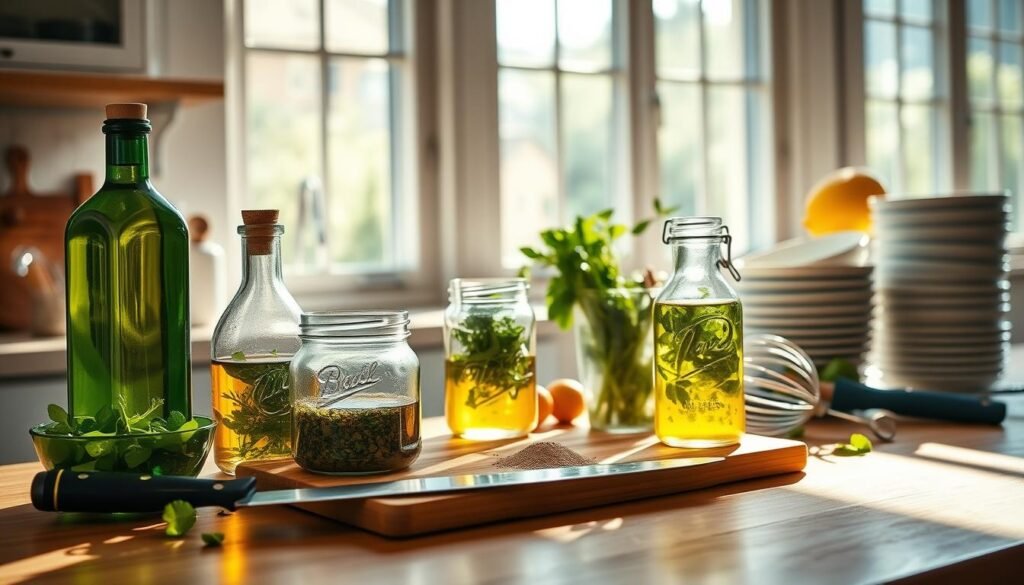Make your salads pop with a variety of tasty salad dressing recipes. This guide shows why the right dressing is key. It makes your salads taste better and more enjoyable.
By making your own dressing, you choose what goes in. This means you can make your salads healthier and tastier. You’ll find everything from classic vinaigrettes to creamy and global flavors. There’s something for everyone’s taste and diet.
Discover simple salad dressing recipes that add excitement to any meal!
Key Takeaways
- Homemade salad dressing allows you to control flavors and ingredients.
- Choosing the right dressing is crucial for enhancing salad flavors.
- Classic and creamy dressings cater to diverse taste preferences.
- Explore unique global flavors to add excitement to your salads.
- Healthy dressing options are available for health-conscious individuals.
- Easy salad dressing recipes make flavor enhancements accessible.
Why Salad Dressing Matters for Flavor Enhancement
Salad dressing is key in cooking, changing how we taste food. It turns fresh veggies into a tasty mix. Dressings boost flavor and let us enjoy different ingredients.
The Role of Salad Dressings in Cuisine
In many cuisines, dressings highlight the natural tastes of foods. The right mix of oils, acids, herbs, and spices can make a salad stand out. They add depth and balance, blending flavors for a better taste.
This shows how important salad dressing is in making dishes memorable.
How Dressing Affects Salad Enjoyment
Think about how dressing changes how we enjoy salads. A good dressing can make simple greens irresistible. It adds strong flavors, making salads more exciting and increasing veggie intake.
This shows why picking the right dressing is crucial for a great meal.
Classic Vinaigrettes to Elevate Any Salad
Classic vinaigrettes are key to great salad dressings. They mix simple flavors with flexibility. By using fresh ingredients, you can make dressings that make your salads shine. Let’s look at two favorites: a balsamic vinaigrette recipe and a zesty lemon herb vinaigrette.
Simple Balsamic Vinaigrette Recipe
A simple balsamic vinaigrette is a mix of rich and sweet flavors. It’s great for both light greens and hearty salads. Here’s how to make it:
- Whisk together 1 part balsamic vinegar and 3 parts extra-virgin olive oil.
- Add a pinch of salt, freshly cracked pepper, and a teaspoon of honey for sweetness.
- Mix in optional ingredients like Dijon mustard or minced garlic for more flavor.
| Ingredient | Quantity |
|---|---|
| Balsamic Vinegar | 1 part |
| Extra-Virgin Olive Oil | 3 parts |
| Honey | 1 teaspoon |
| Salt | to taste |
| Freshly Cracked Pepper | to taste |
| Dijon Mustard (optional) | 1 teaspoon |
Zesty Lemon Herb Vinaigrette
A zesty lemon herb vinaigrette adds a burst of freshness to your salads. It’s perfect for summer salads. Here’s how to make it:
- Combine 2 tablespoons fresh lemon juice with 1/4 cup olive oil.
- Add finely minced garlic and your choice of fresh herbs, like parsley or basil.
- Season with salt and pepper to taste.
These classic vinaigrettes are a great start for flavorful salads. Try different ingredients to make your own unique vinaigrettes. They’ll match your taste and the season’s produce.
Creamy Dressings to Please the Palate
Creamy dressings make salads richer and smoother. They add flavor and a satisfying feel in your mouth. You can make them your own with different tastes. Let’s look at three favorites: homemade ranch, tangy blue cheese, and versatile Caesar.
Homemade Ranch Dressing
Making ranch dressing yourself means you pick the ingredients. It’s fresher and healthier than store-bought. Mix buttermilk, mayonnaise, herbs, and spices for a creamy dressing that goes well with greens and veggies.
Tangy Blue Cheese Dressing
Blue cheese dressing is bold, with blue cheese, sour cream, and yogurt. It’s creamy and full of flavor. It’s great with strong salads, adding a nice contrast to crisp greens and big ingredients.
Versatile Caesar Dressing
Making Caesar dressing at home is easy and rewarding. Use anchovies, lemon juice, garlic, and mayonnaise for a rich dressing. It makes your salad better and beats what you find in restaurants, showing its true taste.
| Dressing Type | Main Ingredients | Flavor Profile |
|---|---|---|
| Homemade Ranch Dressing | Buttermilk, mayonnaise, herbs, spices | Creamy, herby, tangy |
| Tangy Blue Cheese Dressing | Blue cheese, sour cream, yogurt | Rich, sharp, creamy |
| Versatile Caesar Dressing | Anchovies, lemon juice, garlic, mayonnaise | Garlicky, tangy, umami |
Unique Global Flavors to Explore
Exploring unique global flavors can turn your salads into exciting adventures. Trying different dressings not only boosts taste but also expands your cooking skills. The Asian-Inspired Sesame Dressing and the Mediterranean Tzatziki Sauce are great examples of this.
Asian-Inspired Sesame Dressing
This dressing combines sesame oil, soy sauce, and rice vinegar. It creates a true Asian-inspired taste that excites your taste buds. It’s perfect for Asian-style salads or cold noodle dishes.
Adding this dressing to your meals brings a new twist. It makes your dining experience even better.
Mediterranean Tzatziki Sauce
The Mediterranean tzatziki sauce is a refreshing blend of Greek yogurt, garlic, cucumber, and herbs. It’s great as a dressing or dip, perfect for Greek salads or wraps. Its creamy texture and lively flavor make it a standout choice for any meal.

Healthy Options for the Health-Conscious
Looking for healthy salad dressing options doesn’t mean you have to give up taste. You can find delicious alternatives that are good for you and your meals. Avocado lime dressing and Greek yogurt-based dressing are great choices. They add vibrant flavors to your dishes while helping you stay on track with your health goals.
Avocado Lime Dressing
This dressing is made with ripe avocados, zesty lime juice, and olive oil. It’s creamy and packed with nutrients. It’s perfect for mixed greens or as a dip for veggies.
Greek Yogurt-Based Dressings
Greek yogurt-based dressings are another great option. They’re high in protein and creamy, without the extra calories of mayonnaise or sour cream. You can add herbs and spices to make it your own, enhancing your salads and dishes.
How to Make Your Own Dressings at Home
Making your own dressings lets you pick the flavors you like. This way, you get a fresh and tasty addition to your salads. Knowing the basic ingredients is key. You’ll need a base oil, an acid, and seasonings that you like.
Essential Ingredients for Homemade Dressings
The heart of any salad dressing is a few key ingredients. To make your own salad dressing, you’ll need:
- Oil: Olive oil is a favorite, adding a rich taste and texture.
- Acid: Vinegars like balsamic, apple cider, or citrus juices bring brightness.
- Seasonings: Salt, pepper, herbs, and spices add depth to the flavor.
Tips for Perfecting your Dressing
Some tips can make your dressings even better. Here are a few to remember:
- Whisk or blend well to get a smooth dressing.
- Begin with a 3:1 oil to acid ratio and adjust to taste.
- Let the dressing sit for at least 30 minutes to blend flavors.

Dressing on a Budget: Affordable Ingredients
Making tasty salad dressings doesn’t have to cost a lot. You can make salad dressing on a budget by using simple recipes. These recipes use ingredients you might already have at home. With just vinegar, oil, and seasonings, you can make delicious dishes without spending too much.
Best Budget-Friendly Dressings to Make
Here are some easy and tasty dressing recipes that won’t break the bank:
- Balsamic Vinaigrette: Mix 3 parts oil with 1 part balsamic vinegar. Add salt and pepper to taste.
- Mustard Vinaigrette: Start with 1 tablespoon of mustard and 3 tablespoons of vinegar. Slowly add 1/4 cup of oil, then season.
- Simple Yogurt Dressing: Blend plain yogurt with lemon juice, salt, and herbs for a creamy dressing.
Utilizing Pantry Staples for Flavor
Your kitchen probably has many pantry staples that can make dressings special. Here are some examples:
| Pantry Staple | Use in Dressing |
|---|---|
| Olive Oil | Great for most vinaigrettes and creamy dressings. |
| Vinegar (Balsamic, Apple Cider) | Brings acidity and tang to balance flavors. |
| Mustard | Boosts flavor depth and helps mix ingredients. |
| Garlic | Gives a strong flavor in both creamy and oil-based dressings. |
| Herbs and Spices | Adds extra flavor without extra cost. |
Pairing Dressings with Different Salad Types
Choosing the right dressing can make your salad better. It brings out the flavors and textures. For leafy greens, pick lighter vinaigrettes. They let the greens’ natural taste shine, making the salad refreshing.
Pasta salads do well with creamier dressings. These dressings wrap around the ingredients, adding richness. Knowing these pairings helps you make your salads better and try new combinations.
Pairing Dressings with Greens
For salads with mostly greens, a light dressing is key. Choose a lemon vinaigrette or a light ranch. These dressings boost the greens’ taste and add a nice acidity.
When pairing salad dressings, think about how they match the greens’ flavor.
Dressings for Pasta Salads
Pasta salads need a dressing that coats everything well. Creamy dressings like Italian or tangy buffalo ranch work best. A good pasta salad dressing ties together pasta, veggies, and proteins.

Tips for Storing and Serving Dressings
Storing your homemade salad dressings right is key to keeping their taste and quality. Most can stay in an airtight container in the fridge for up to a week. But, remember, fresh herbs lose their strength over time, so use them quickly for the best flavor.
Labeling your containers with the date you made them helps keep track of freshness. This way, you know when it’s time to make a new batch.
When serving salad dressing, how you do it matters a lot. Warming vinaigrettes a bit before drizzling them over your salad can make a big difference. It lets the flavors mix better, making the dressing taste richer and more balanced.
By following these tips for storing and serving, your salads will stay fresh and tasty. Enjoy every bite!
FAQ
What is the best homemade salad dressing for beginners?
How can I make a creamy salad dressing healthier?
What are some easy salad dressing recipes I can try?
How do I store homemade salad dressing?
Are there low-calorie salad dressing options available?
Can I use salad dressings as marinades?
What are the health benefits of using homemade salad dressings?
How do I find the perfect pairing of dressings with my salads?
check this recipe out for more
